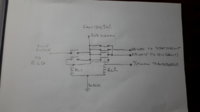Mmmmmm! Didn't quite come out as expected:
Here is the explanation
The schematic shows the start condition just after switching the ignition on.
The following condition are true:
1/ Via RL2, 12V is available to the Red/Yellow ignition circuit
2/ Via RL2, 12V is available to the other Red/Yellow for the starter circuit
3/ There is no 12V to the RLU
Start the engine:
4/ The Yellow from the alternator now provides power which operates RL2.
5/ RL2 now opens the contacts removing the 12V from the start circuit (other Red/Yellow).
6/ There is a momentary interruption of the supply to ignition as the contacts change.
7/ RL1 receives 12V from RL2 and changes state.
8/ RL1 now provides 12V to itself and it is now locked on until the ignition is switched off.
9/ RL1 now supplies 12V to the RLU via the Blue/Black wire enabling the headlights.
10/ This state continues irrespective of the engine until the ignition is turned off.
It would be possible to continue the isolation of the start circuit via extra Normally Closed contacts on RL1 but that would require the ignition to be turned off then on again to avoid the 'starter plus headlight' problem, but in a stall situation, speed is essential!






